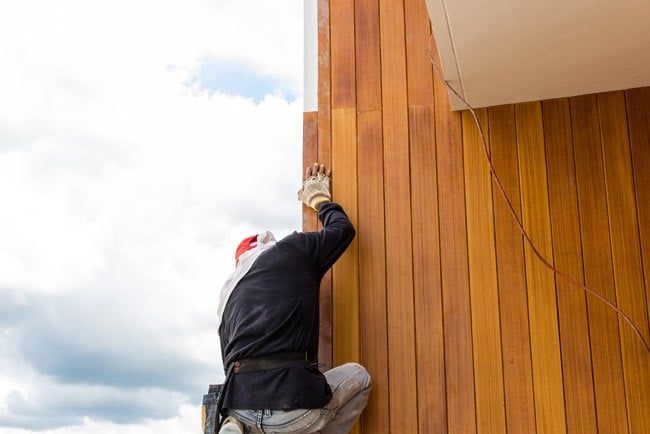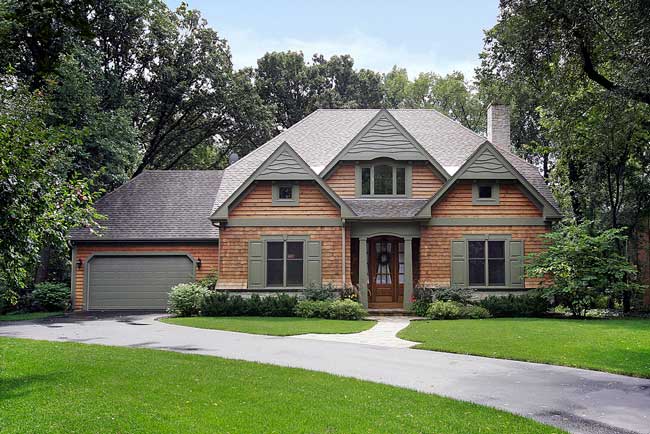Siding and Exterior Material Breakdown
The siding material you use for your home has an impact on the curb appeal of your home, as well as protecting your home from extreme weather conditions such as wind, rain, and hail. Depending on the location of your residence, you should be considering what the best option is for your home to keep it protected and looking great.
There are many different types of siding materials available and it’s up to you to decide what option fits your needs best. In this article, we will try and help you make an informed decision when deciding what type of siding material to use on your home. From vinyl siding to cement board materials, here is our siding and exterior material breakdown.
Vinyl and Plastic Siding Materials

Vinyl siding is a very versatile material and is one of the most popular options on the market. It comes in a variety of shapes, colors, and textures that make it a great choice for homes all over Canada. Vinyl siding is manufactured from polyvinyl chloride which is a durable compound and comes in the following profiles:
- Vertical
- Single
- Double
- Triple
- Double Dutch
- Solid
- Vented Perforated
- Vented Basketweaves
Depending on the look and needs of your home will determine which style to choose. Vented siding increases the airflow of the home but can be more susceptible to water damage in areas with heavy rains.
Vinyl styles come in many different shapes and textures. You can acquire siding that looks just like wood such as cedar plank styles that give the home a beautiful rugged look that wood typically gives.
Some homeowners are even mixing and matching different vinyl styles to come up with unique and innovative designs that make their residences stand out from traditionally styled homes. Combing styles such as cedar shake vinyl siding and board and batten vinyl siding result in a beautiful and unique style that truly stands out.
Metal Siding Materials

Highly Durable
Metal siding is arguably the most durable siding material on the market. Warranties for these products can reach as much as 40 years, but when properly installed and maintained, metal siding can last decades longer than that. Metal siding is extremely tough and can take a beating from extreme weather conditions and show no signs of damage at all depending on the material. Steel siding is recommended for areas with hailstorms, as aluminum siding can be prone to damage from this sort of extreme weather. Make sure to take these things into account before going ahead with aluminum metal siding.
With metal siding, you don’t need to worry about cracking, warping, or chipping. On top of this, no pest can work its way inside the material and destroy the structural integrity of your siding. Some other perks include being extremely fire retardant especially when compared to wood shakes.
Low-Maintenance
Another benefit to metal siding is that it requires little maintenance to take care of over the years. Just make sure the material you purchase has the proper protective coatings on it and all you have to do is spray it down and clean it from time to time. It is suggested that you wash your metal siding 2-3 times a year to avoid unwanted chemical reactions from dirt, debris, and environmental toxins. Keeping your siding clean will minimize erosion over the lifetime of your siding.
Energy Efficient
Are you worried about the energy efficiency of your home? Metal siding is a great choice for regulating the energy efficiency of your home and keeping heat locked in the home. On top of this, if you live in a hotter climate, you can use reflective coatings to reflect UV rays away to help cool down the home. Metal siding can effectively increase the comfort of your home if used correctly.
Sustainable and Reduces Your Carbon Footprint
One last thing about metal siding, it is completely sustainable and every inch can be recycled. If you are an environmentally conscious homeowner, metal siding may be the option for you. Metal siding meets all the criteria for green building codes and most of the materials are manufactured from recycled products. This also means that your siding at the end of its extremely long lifetime can be recycled and used to create new products, effectively reducing your carbon footprint drastically.
James Hardie Fiber Cement Board Siding

James Hardie cement board siding is one of the finest materials on the market. It can be quite expensive, but it performs extremely well under all weather conditions, is pest resistant, fire-resistant, and more.
What Is Fiber Cement Board Siding?
Fiber cement board siding is created using wood pulp, cement, and a filler such as fly ash or silica sand. It creates a flexible and resilient compound that looks similar to wood siding but has none of the weaknesses that wood typically has. This type of siding looks amazing and is highly regarded as one of the best materials to use to side your home.
Extremely Durable and Requires Little Maintenance
Fiber cement board siding is extremely durable and is unaffected by wind, rain, hail, and cold. It requires little maintenance and is completely termite, rot, and fire proof. This type of siding is one tough material that takes quite a bit of damage. All of this durability without compromising the aesthetics of the home.
Additional Information
One of the things to keep in mind about fiber cement board is that it has to be finished, meaning it must be painted or stained. Make sure that when you are picking out your siding, that the manufacturer takes care of this for you. Also, it’s highly recommended that your contractor use rustproof stainless steel nails. They should also be priming all cuts and caulking any joints with an exterior-grade sealant that is paintable and remains flexible.
Wood Siding Materials

Wood siding materials are typically manufactured from cedarwood or redwood trees. These types of wood have better resistances to decay. Wood siding can be stylized with stains or oils giving a beautiful look that lasts many years.
Engineered Wood Materials
Many homeowners have been using engineered wood to side their homes with as well. Engineered wood combines treated wood strands/fibers with adhesive resins to create a composite material that is more durable and stronger than traditional wood siding materials.
These composite materials can be treated additionally by special water-resistant waxes which allows the material to do well in areas with lots of rain and humidity.
Wood Materials Require Lots of Maintenance
One of the cons of wood siding is that it has to be stained and painted quite frequently in order to keep it from warping and deteriorating over time. Wood siding is also susceptible to termite infestations and can completely destroy the structural integrity of the wood. Make sure you manage pests effectively and proactively to make sure that your siding isn’t damaged permanently.
It’s keen to remember that wood siding is one of the oldest forms of siding around. It may give your home that rugged and rough look that is sought after by some homeowners, but it requires much more maintenance than the other materials listed here. In order to make sure that your wood ages gracefully, you must stain, paint, and treat your wood siding multiple times over the course of its lifetime.
Conclusion
There are many different types of siding materials on the market from vinyl to fiber cement board. Choosing which one is right for you depends on your aesthetic requirements, budget, climate, and location. Trying to find a material that will withstand the elements, look fantastic, and hold up over time can be tough to do. Make sure to consult a professional that knows what they are doing to come up with a proper solution for you.




